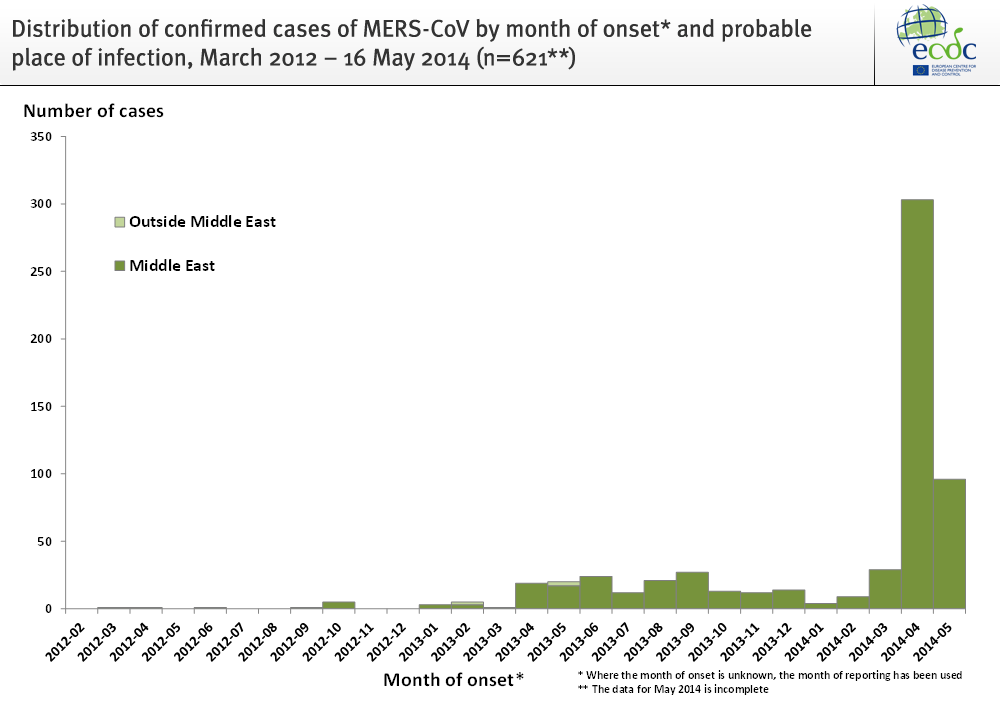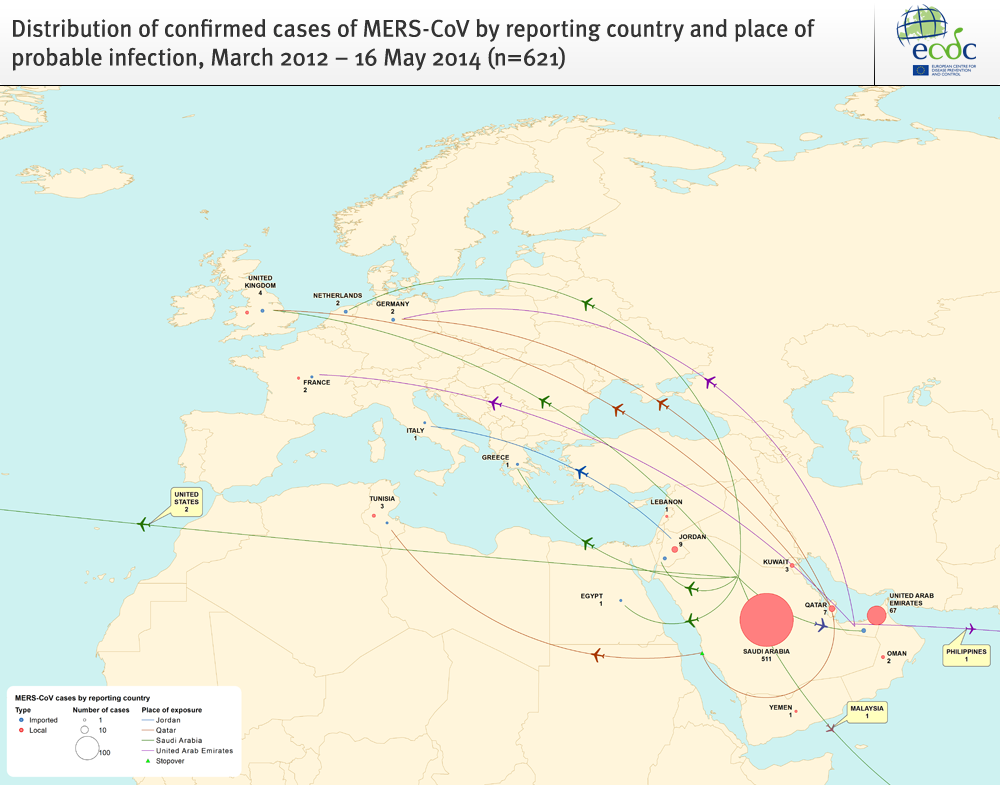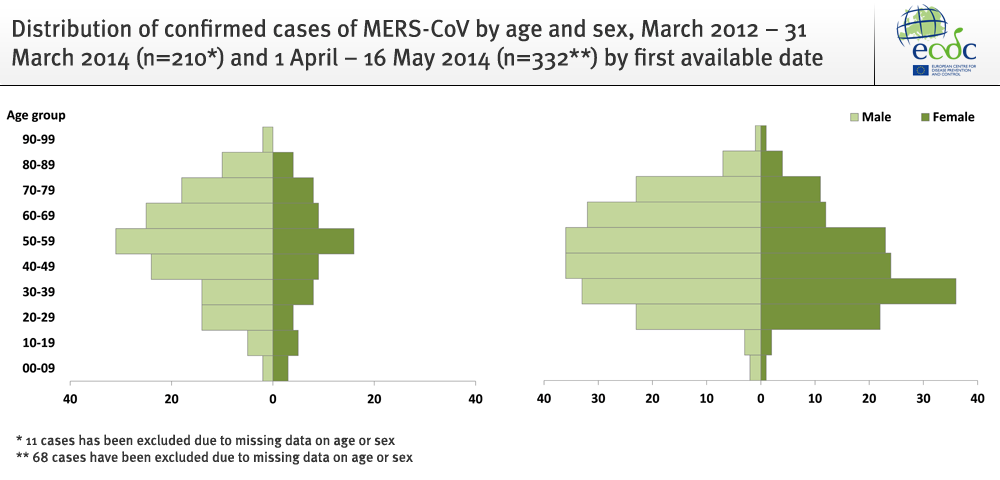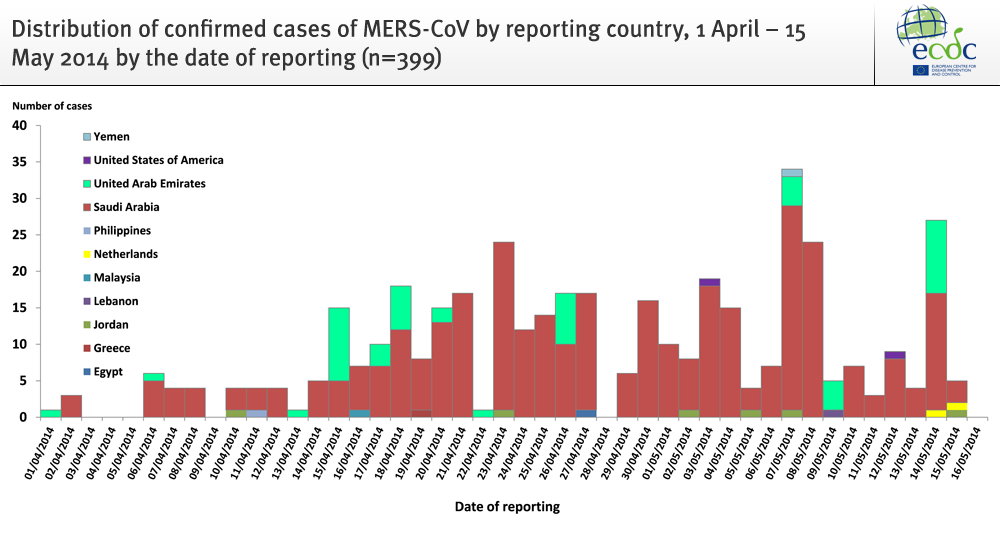[Source: European Centre for Disease Prevention and Control (ECDC), full page: (LINK).]
Epidemiological update: Middle East respiratory syndrome coronavirus (MERS-CoV)
16 May 2014
ECDC notes the decision of Margaret Chan, the Director General of WHO, on 14 May 2014 not to call the Middle East respiratory syndrome coronavirus (MERS-CoV) outbreak a Public Health Emergency of International Concern (PHEIC) as the conditions have not been met yet.
This decision was based on the advice of the WHO Emergency Committee under the IHR on MERS-CoV.
However the committee indicated that, based on current information, ?the seriousness of the situation had increased in terms of public health impact, but that there is no evidence of sustained human-to-human transmission.?
Since April 2012 and as of 16 May 2014, 621 cases of MERS-CoV infection have been reported globally, including 188 deaths.
On 11 May 2014 a second imported case of MERS-CoV was confirmed by the United States' Centers for Disease Control and Prevention.
On 13 May 2014, National Institute for Public Health and the Environment (RIVM) in the Netherlands reported the first imported case of MERS-CoV in the country.
On 15 May 2014 a second case, who travelled with the first case, was reported.
Confirmed cases and deaths by region:
____
Most cases have either occurred in the Middle East or have direct links to a primary case infected in the Middle East. Local secondary transmission following importation was reported from the United Kingdom, France, and Tunisia.
______
Figure 1.

______
In April 2014, four countries (Philippines, Greece, Malaysia and Egypt) notified imported cases from Arabian Peninsula. In May the US and Netherlands reported the two first imported cases from Saudi Arabia (Figure 2).
______
Figure 2.

_____
As of 16 May 2014, the case-fatality ratio is 30%.
For the cases were age and sex is known the male to female ratio is 1.7:1.
Among the 617 cases with known age, the average age is 48.5 years.
Out of the 543 cases for whom age and sex is known, 245 (45%) have been males aged 40 years and above.
______
Figure 3.

______
The number of cases by reporting date increased markedly: in April 233 cases were reported and to date 181 cases in May.
Between March 2013 and March 2014 the monthly average of reported cases was 15.
Among these 414 cases, 348 (84%) were reported by Saudi Arabia, 50 cases (12%) by the United Arab Emirates, six cases were reported by Jordan, two cases by the United States and Netherlands, one case each by Egypt, Greece, Malaysia, Philippines, Lebanon and Yemen (Figure 4).
The cause of the rapid increase in cases in April is unknown.
______
Figure 4.

______
ECDC continues to monitor information on the situation on MERS-CoV worldwide.
In earlier Rapid Risk Assessments, ECDC concluded that the risk of importation of MERS-CoV to the EU was expected to continue and the risk of secondary transmission in the EU remains low.
The conclusions of the assessment provided in the ECDC rapid risk assessment (RRA) on 24 April 2014 remain valid.
More about MERS-CoV
-
-------
Epidemiological update: Middle East respiratory syndrome coronavirus (MERS-CoV)
16 May 2014
ECDC notes the decision of Margaret Chan, the Director General of WHO, on 14 May 2014 not to call the Middle East respiratory syndrome coronavirus (MERS-CoV) outbreak a Public Health Emergency of International Concern (PHEIC) as the conditions have not been met yet.
This decision was based on the advice of the WHO Emergency Committee under the IHR on MERS-CoV.
However the committee indicated that, based on current information, ?the seriousness of the situation had increased in terms of public health impact, but that there is no evidence of sustained human-to-human transmission.?
Since April 2012 and as of 16 May 2014, 621 cases of MERS-CoV infection have been reported globally, including 188 deaths.
On 11 May 2014 a second imported case of MERS-CoV was confirmed by the United States' Centers for Disease Control and Prevention.
On 13 May 2014, National Institute for Public Health and the Environment (RIVM) in the Netherlands reported the first imported case of MERS-CoV in the country.
On 15 May 2014 a second case, who travelled with the first case, was reported.
Confirmed cases and deaths by region:
- Middle East:
- 1) Saudi Arabia: 511 cases/160 deaths
- 2) United Arab Emirates: 67 cases/9 deaths
- 3) Qatar: 7 cases/4 deaths
- 4) Jordan: 9 cases/4 deaths
- 5) Oman: 2 cases/2 deaths
- 6) Kuwait: 3 cases/1 death
- 7) Egypt: 1 case/0 deaths
- 8) Yemen: 1 case/1 death
- 9) Lebanon: 1 case/0 deaths
- Europe:
- 10) UK: 4 cases/3 deaths
- 11) Germany: 2 cases/1 death
- 12) France: 2 cases/1 death
- 13) Italy: 1 case/0 deaths
- 14) Greece: 1 case/0 deaths
- 15) Netherlands: 2 cases/0 deaths
- Africa:
- 16) Tunisia: 3 cases/1 death
- Asia:
- 17) Malaysia: 1 case/1 death
- 18) Philippines: 1 case/0 deaths
- Americas:
- 19) United States of America: 2 cases/0 deaths
____
Most cases have either occurred in the Middle East or have direct links to a primary case infected in the Middle East. Local secondary transmission following importation was reported from the United Kingdom, France, and Tunisia.
______
Figure 1.

______
In April 2014, four countries (Philippines, Greece, Malaysia and Egypt) notified imported cases from Arabian Peninsula. In May the US and Netherlands reported the two first imported cases from Saudi Arabia (Figure 2).
______
Figure 2.

_____
As of 16 May 2014, the case-fatality ratio is 30%.
For the cases were age and sex is known the male to female ratio is 1.7:1.
Among the 617 cases with known age, the average age is 48.5 years.
Out of the 543 cases for whom age and sex is known, 245 (45%) have been males aged 40 years and above.
______
Figure 3.

______
The number of cases by reporting date increased markedly: in April 233 cases were reported and to date 181 cases in May.
Between March 2013 and March 2014 the monthly average of reported cases was 15.
Among these 414 cases, 348 (84%) were reported by Saudi Arabia, 50 cases (12%) by the United Arab Emirates, six cases were reported by Jordan, two cases by the United States and Netherlands, one case each by Egypt, Greece, Malaysia, Philippines, Lebanon and Yemen (Figure 4).
The cause of the rapid increase in cases in April is unknown.
______
Figure 4.

______
ECDC continues to monitor information on the situation on MERS-CoV worldwide.
In earlier Rapid Risk Assessments, ECDC concluded that the risk of importation of MERS-CoV to the EU was expected to continue and the risk of secondary transmission in the EU remains low.
The conclusions of the assessment provided in the ECDC rapid risk assessment (RRA) on 24 April 2014 remain valid.
More about MERS-CoV
-
-------